Californian Snow Auto Cannabis Strain Week-by-Week Guide

- 1. Grow specification
- 2. Grow set up
- 3. Germination and seedling stage | week 1
- 4. Early veg | week 2
- 5. Mid veg | weeks 3-4
- 6. Transition (pre-flower) | week 5
- 7. Early flower | weeks 6-7
- 8. Mid flower (bulk phase) | weeks 8-9
- 9. Ripening and harvest | week 10 (and beyond)
- 10. The outcome
- 10. a. Californian snow auto yield
- 10. b. Californian snow auto smoke report
- 11. In conclusion
If you are looking for a frosty and potent strain that will make you feel like you are in a winter wonderland, look no further than Californian Snow. This cross between an old school Sativa from California and a Canadian Ruderalis is worth trying for anyone who wants to experience a unique and enjoyable high that will make you smile like a kid on Christmas morning.
In our week-by-week guide to growing Californian Snow Auto, we will show you this amazing plant's progress through all stages from seed to harvest so that when you cultivate this strain yourself, you know its timeline and grow stages and put to full use our tips and guideleines.
1. Grow Specification
Californian Snow is a remarkable strain that combines the best of both worlds with its Sativa-dominant genetic composition (70%) and a more modest infusion of Indica (30%). It exhibits impressive growing characteristics, reaching a height of 80-130 cm, making it a substantial presence in any garden. Its XXL size promises bountiful yields, and the plant always fulfills this promise.
Indoors, Californian Snow rewards cultivators with a generous yield ranging from 400 to 550 g/m2. Outdoors, the plant thrives as well, providing a harvest of 50-250 grams per plant. These abundant yields are a testament to its resilience and vigor throughout its growth cycle. With a flowering period of 9-10 weeks, this strain demonstrates its efficiency in transforming into a smokable product.
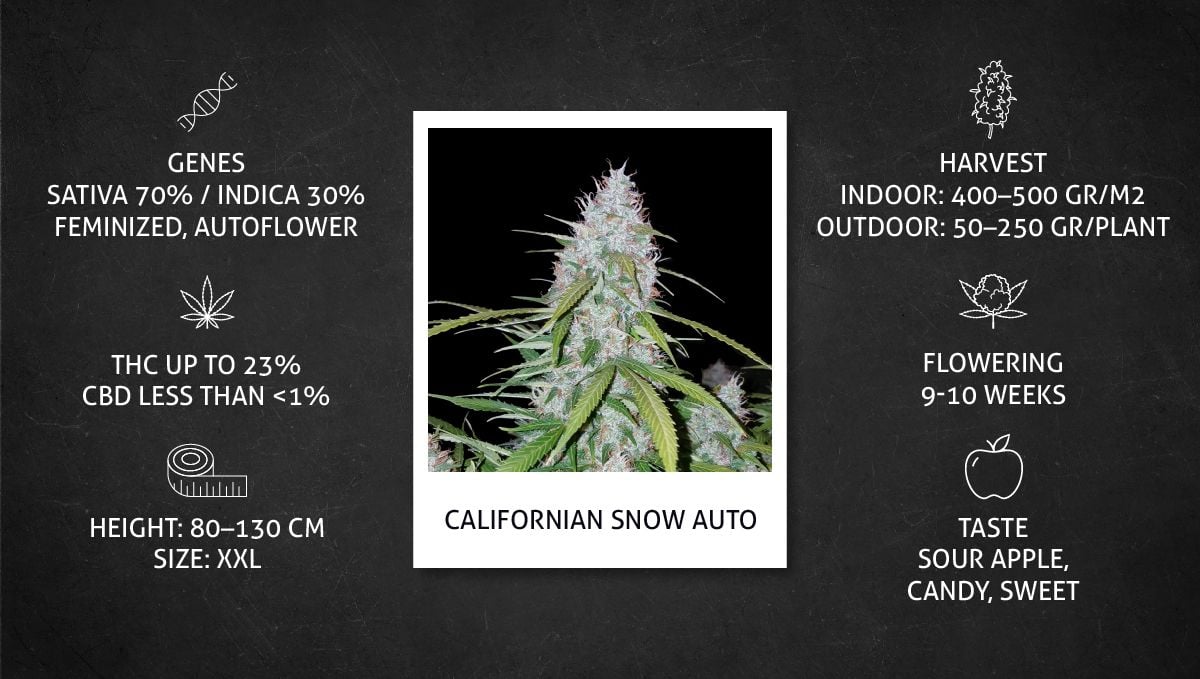
Once harvested and properly cured, Californian Snow delights the senses with its exquisite taste. The combination of flavors includes notes of sour apple, candy, and sweetness, creating a tantalizing experience for the taste buds. With THC levels reaching up to an impressive 23%, this strain packs a potent punch, ensuring a captivating and enjoyable high.
2. Grow Set Up
Californian Snow Auto is a beloved strain from Fast Buds that has captivated growers for quite some time. The best part is, if you're interested in growing this autoflower variety yourself, you'll find a wealth of valuable information online. In this comprehensive guide, we have carefully handpicked four grow diaries from a vast selection available. Our focus was on diaries where growers followed top-notch cultivation practices. What it means for you is that you can follow their lead and achieve remarkable results too.
| Grow Space | Light | Medium | |
|---|---|---|---|
| A | 0.37 m2 | 100W FL | Coco coir / Perlite |
| B | 1 m2 | 400W HID | Soil |
| C | 0.36 m2 | 125W LED | Coco coir |
| D | 0.2 m2 | 300W LED | Soil / Perlite |
Additionally, we made it a point to feature Californian Snow Auto in diverse scenarios and setups whenever possible. By doing so, we aim to help you adapt this exceptional genetic strain to suit your personal growing style. However, rest assured that Californian Snow Auto has consistently demonstrated its adaptability, allowing it to thrive and produce top-tier yields under various conditions. Whether you're a seasoned grower or just starting out, this strain is sure to deliver an exceptional growing experience.
3. Germination And Seedling Stage | Week 1
Establishing the ideal conditions in your indoor grow space is more important than ever when your cannabis just begins its cultivation journey as seedlings and young plants are particularly delicate. It is essential to focus on maintaining a warm temperature and a pleasant level of humidity in the air to promote healthy growth and development.
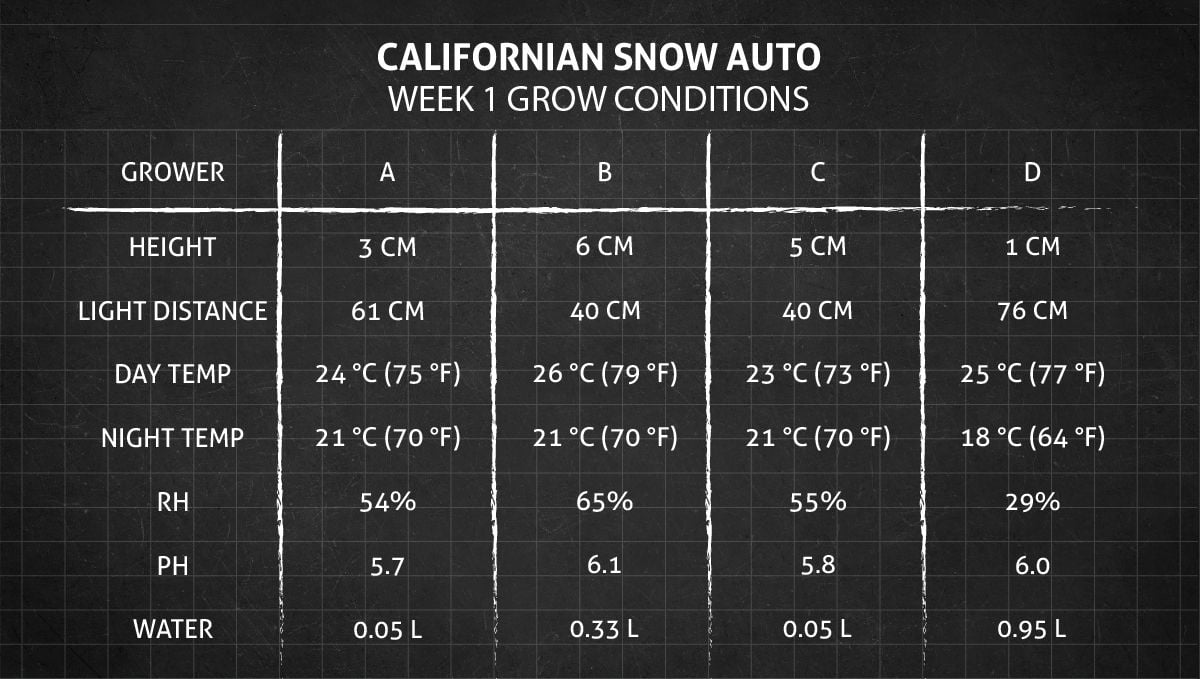
For novice gardeners, the process of germinating cannabis seeds can often evoke feelings of worry and even panic. We understand that the seeds weren't exactly dirt cheap for you and you want every one of them to germinate successfully. However, relax and just breathe out: high-quality seeds from reputable breeders, such as Fast Buds, possess robust resilience, and nurturing them to life is not as daunting as it may seem.
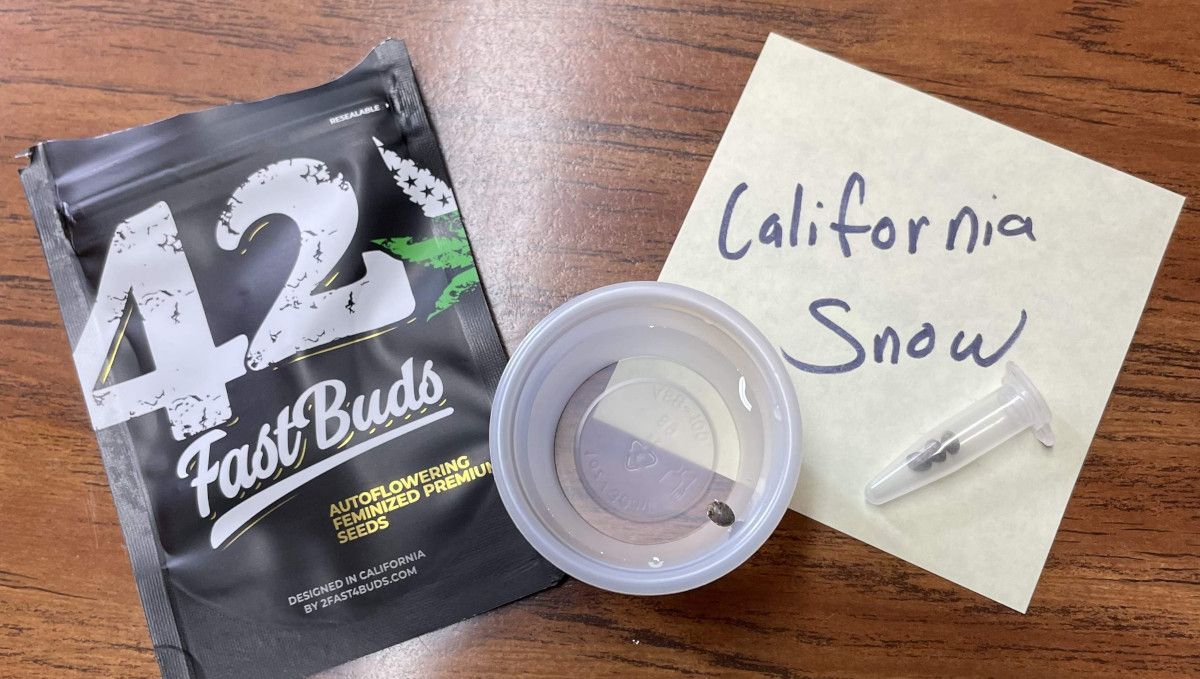
In reality, you only need three key elements: a comfortably warm environment reminiscent of springtime, moisture, and darkness. By providing these conditions, your seeds can sprout within a span of 1-3 days. Several methods can create these optimal conditions, and one of the simplest approaches involves placing the seeds between moist paper towels and sandwiching them between plates in a warm, dark place.
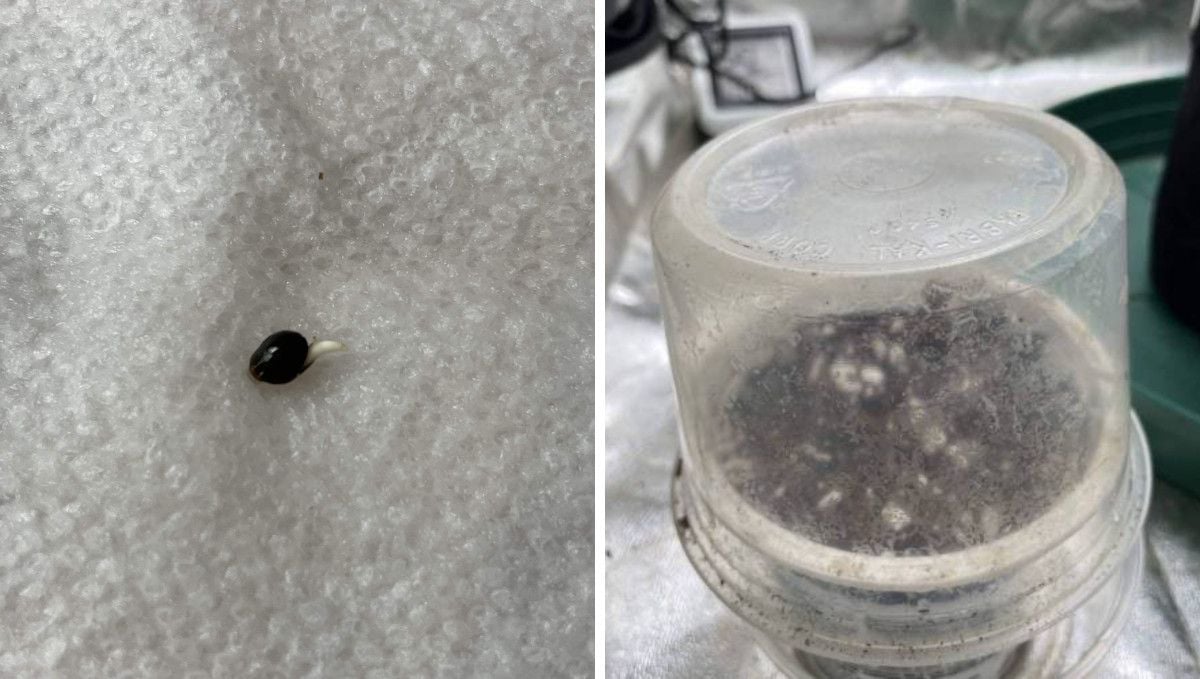
Some growers prefer the pre-soaking method, letting the seeds float in a glass of water until they crack open and reveal the taproot, others even let them floating until the taproot gets long enough. Just don't forget that whatever method you choose, it's important to remember that warmth, moisture, and darkness are fundamental requirements for successful germination.

Once your seed has successfully popped and the taproot has grown to approximately half an inch (a little over 1 cm) in length, it's time to carefully transfer it into the growing medium of your choice.
When cultivating autoflowering strains, we recommend taking the final, larger pot right from the start. This approach eliminates the need for transplanting, which can pose risks to the delicate root system. However, for experienced gardeners, smaller containers such as solo cups are also an option, as they can offer certain conveniences, including ease of watering.
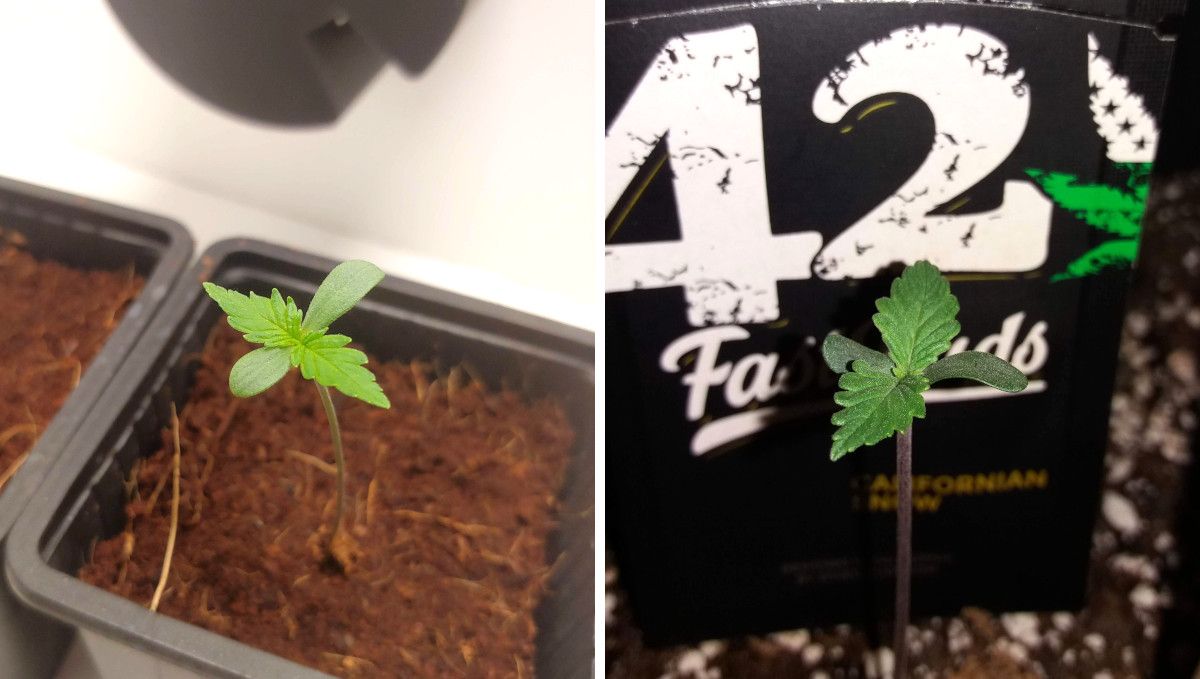
Remember to provide adequate drainage in your pots to prevent waterlogging, which could lead to root rot. Additionally, maintaining a proper balance of moisture is essential during the seedling stage, as excessive watering can hinder root development. Aim for a damp but not overly saturated growing medium.
4. Early Veg | Week 2
As you dive into the second week from seed, you might still find your little seedling looking petite, but don't let that fool you! Beneath the surface, the root ball has been growing like crazy, making the above-ground part tougher and ready to handle slightly cooler temperatures and lower humidity levels.
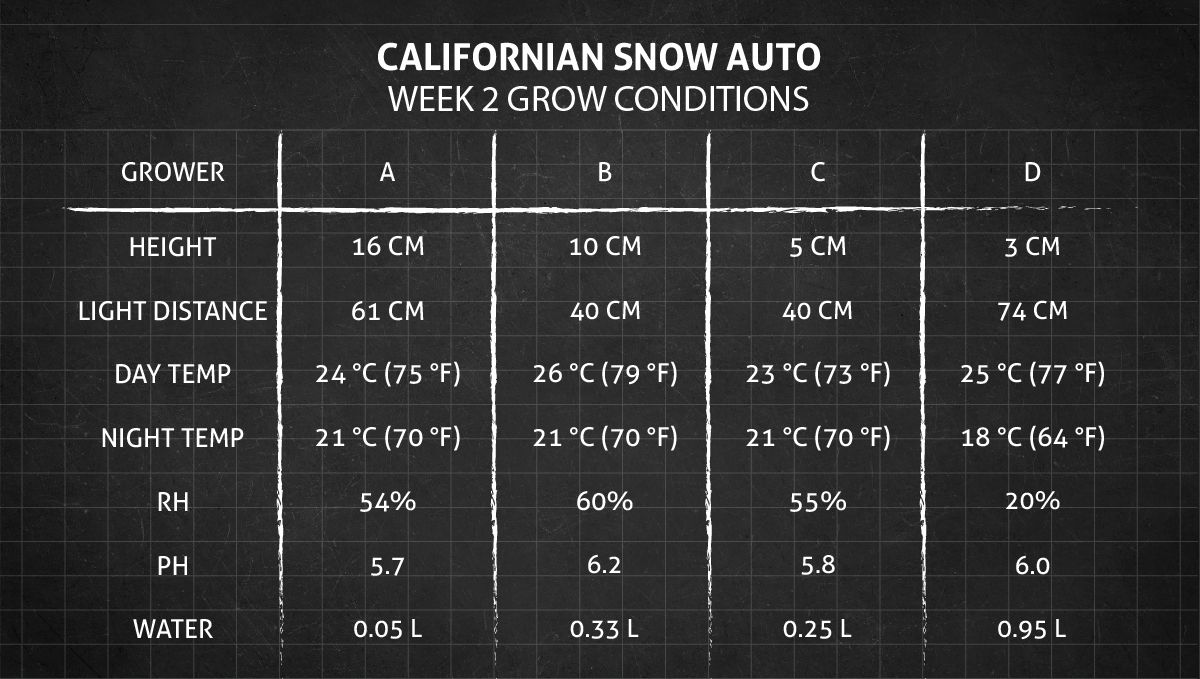
Now, in this week, get ready to witness some serious growth spurt action! By day 10, the second pair of leaves on a healthy seedling should catch up and surpass the size of the first set. It's like a little green race happening right before your eyes. This is a great indicator to gauge if your autoflower is liking the environment you've set up for it.
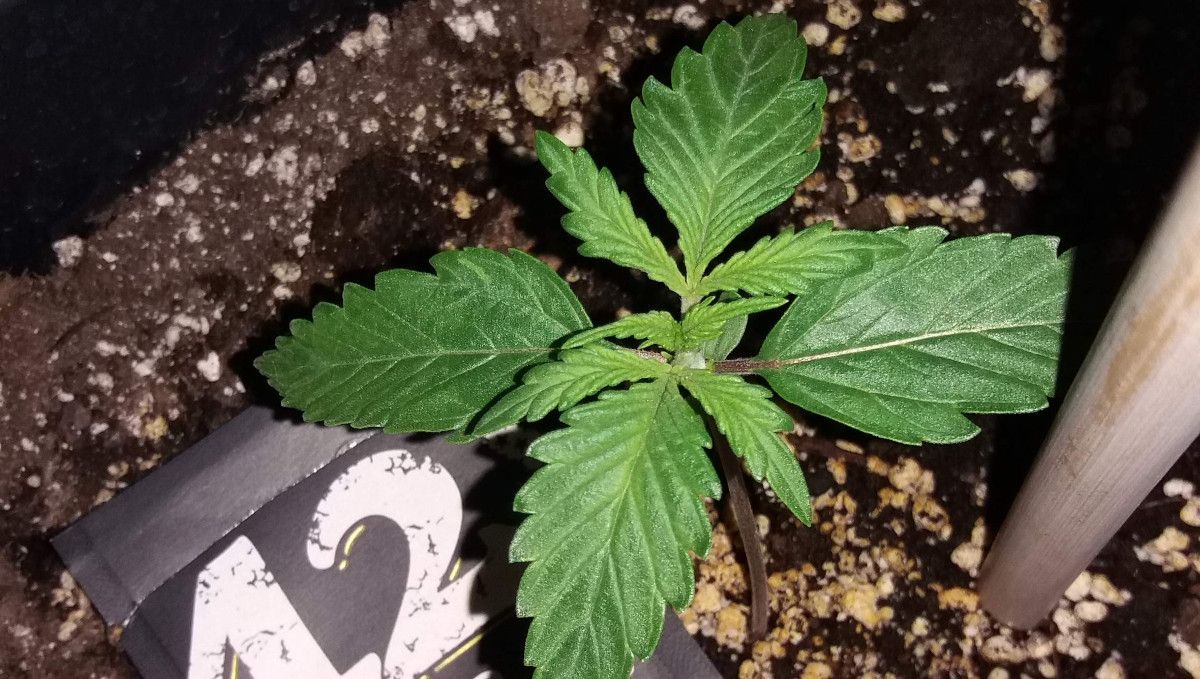
We should also mention lighting as it's a critical factor to keep an eye on. You want to strike the right balance: your seedling shouldn't be stretching like a giraffe, desperately reaching for support. On the flip side, it shouldn't be hugging the ground as if all the light is just flattening it. Adjust the height or intensity of your light accordingly to keep it in the sweet spot.

Now, when it comes to training your plant, most gardeners tend to hold off during this period. They let it do its thing and grow naturally. But if you're dealing with limited space vertically, you can start managing that leafy canopy even at this early stage.
With autoflowers, the safest approach is to gently bend and secure the main stem. However, if you're a seasoned grower feeling adventurous, you can experiment with some high-stress techniques like FIMing or topping. But remember: do this only if your little buddy is strong and hearty enough to handle it.

Soil growers usually play it safe and skip the nutrient game in the first week. But once they hit week 2, some growers start adding nutrients to the mix. Your little seedling has been munching on the stored plant food in the medium, but it might be getting a bit hungry now, especially if you started it off in a small container like a solo cup.
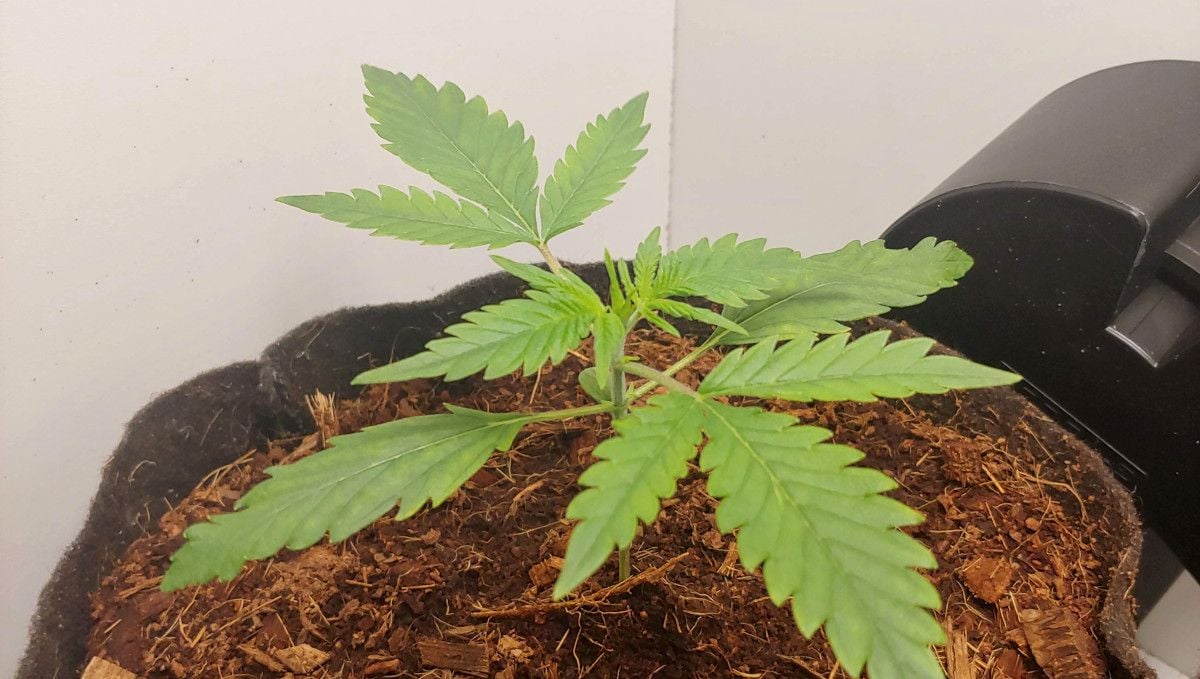
If you've got bigger pots with nutrient-rich soil, you can still keep it simple and stick with plain water throughout the veg phase and even into flowering. Now, here's where some real organic enthusiasts take it to the next level. They create what's called "super soil," which lets them rely on compost teas alone from seed to harvest.
5. Mid Veg | Weeks 3-4
In weeks 3 and 4, get ready for the explosive vegetative growth of your autoflower! Don't stress too much about the exact temperature and humidity, as your plant has reached a mature stage and can handle a wider range of conditions.

During this exciting phase, your autoflower will undergo remarkable growth. The fan leaves will expand, and you'll see an increase in the number of branches. It's like watching a tiny seedling transform into a tall, elegant plant or a dense, bushy wonder.

Don't underestimate the magic of canopy management! Especially for those growing Sativa-dominant autoflowers, such as Californian Snow, training becomes your best friend. These strains have a knack for stretching and reaching for the sky, so shaping your canopy early on is crucial.
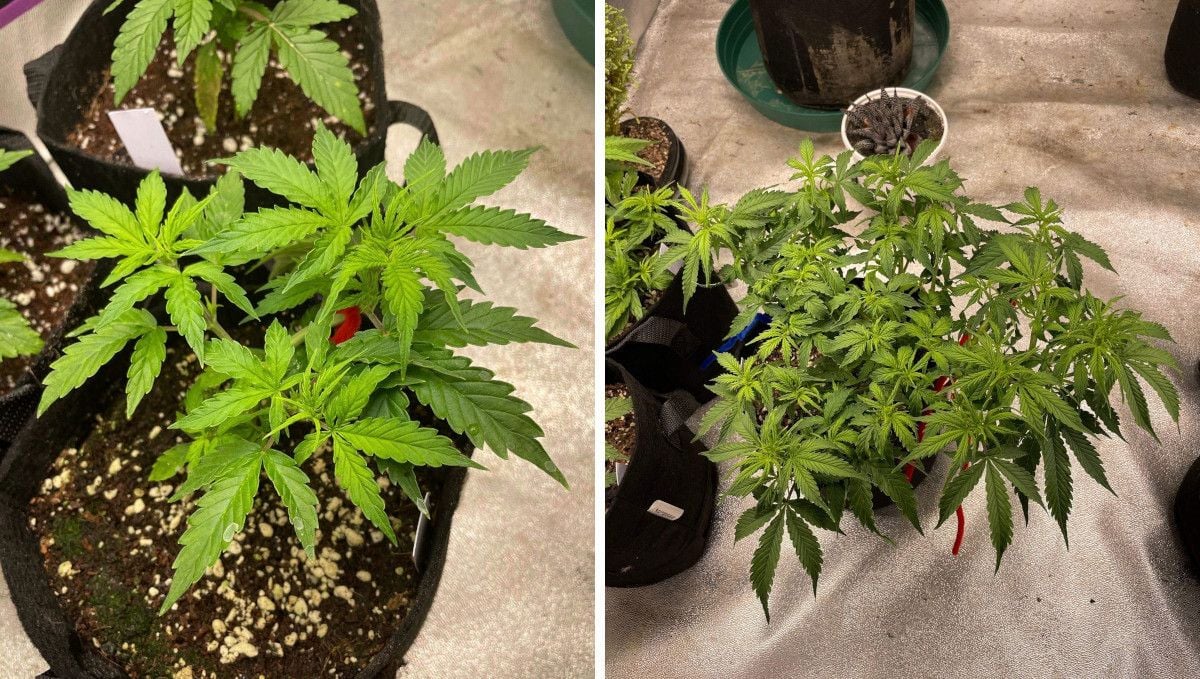
Low-stress training (LST) or gently bending and securing the main stem can help you maintain an even and controlled growth pattern. This not only prevents height-related issues down the line but also ensures every bud site gets its fair share of that precious light.
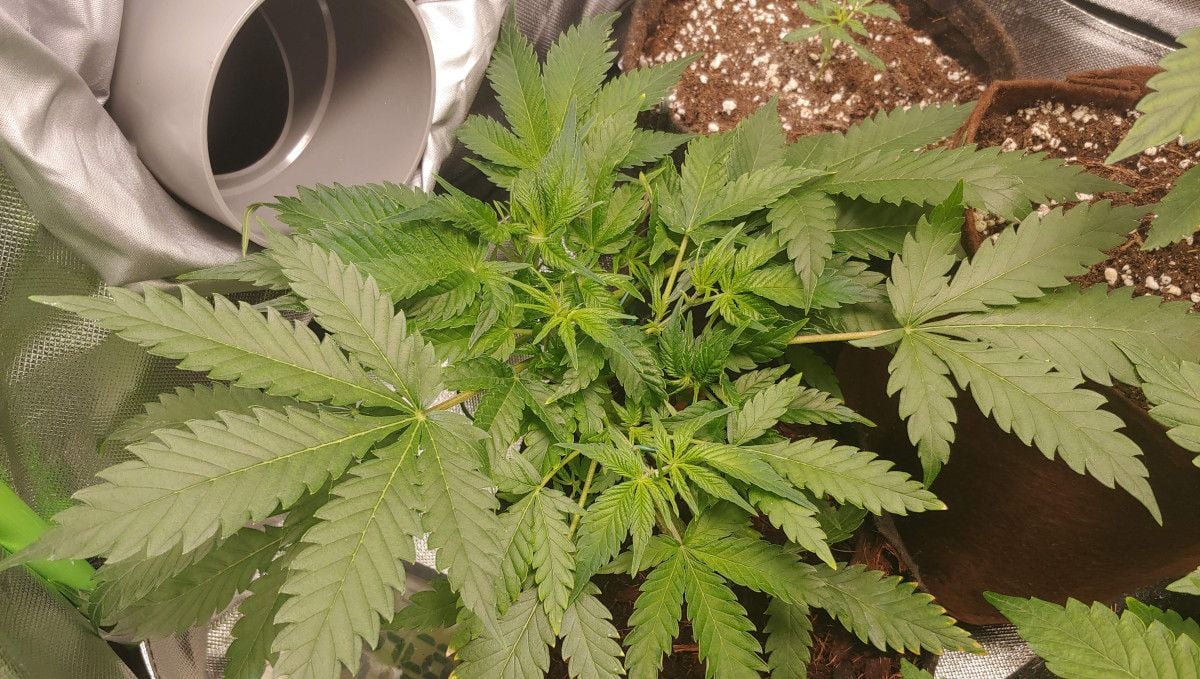
When it comes to feeding your cannabis plants during this growth spurt, it's important to consider their needs. Sativa-dominant autoflowers are generally lighter feeders compared to other types. They prefer a milder nutrient concentration and can be a bit sensitive to overfeeding. So, keep an eye on their response and provide them with a balanced feeding schedule. Remember, it's better to give them a gentle diet rather than overwhelming their delicate systems.
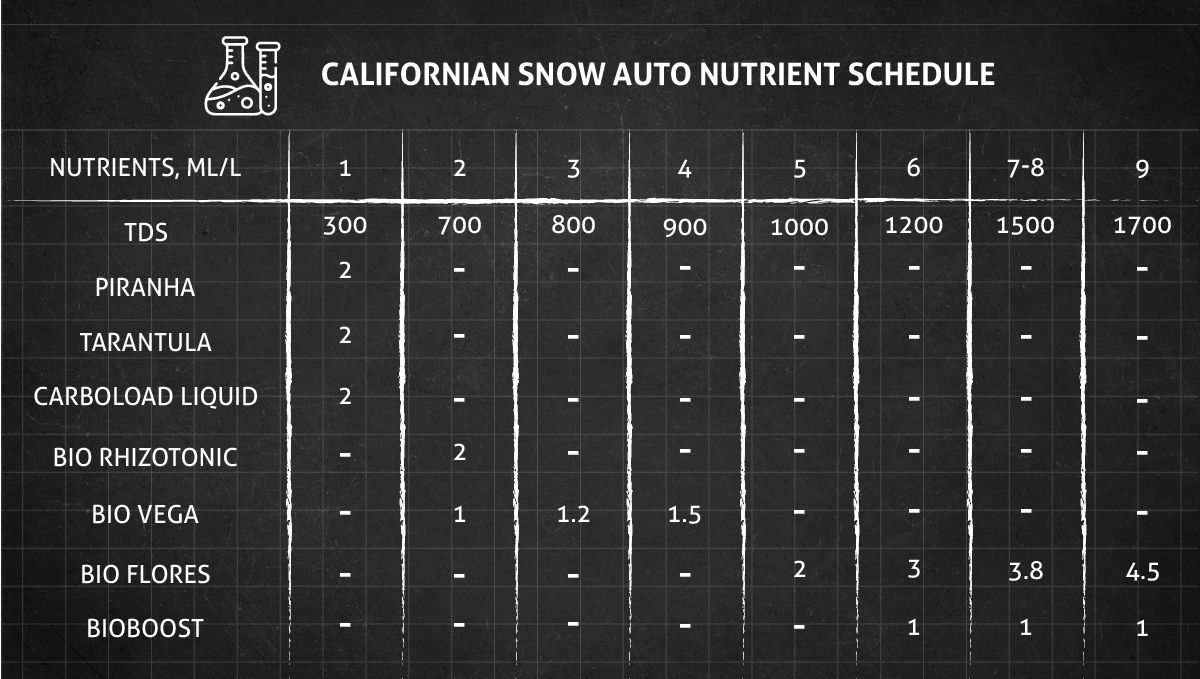
Be on top of your game during the vegetative stage because it will come to a close soon. Once the flowering phase begins, new branches won't emerge, limiting the number of bud sites and the potential final yield. So, embrace the effectiveness of canopy management, strike the right balance of nutrients for your autoflowers, and shower your plants with all the tender loving care you can provide.
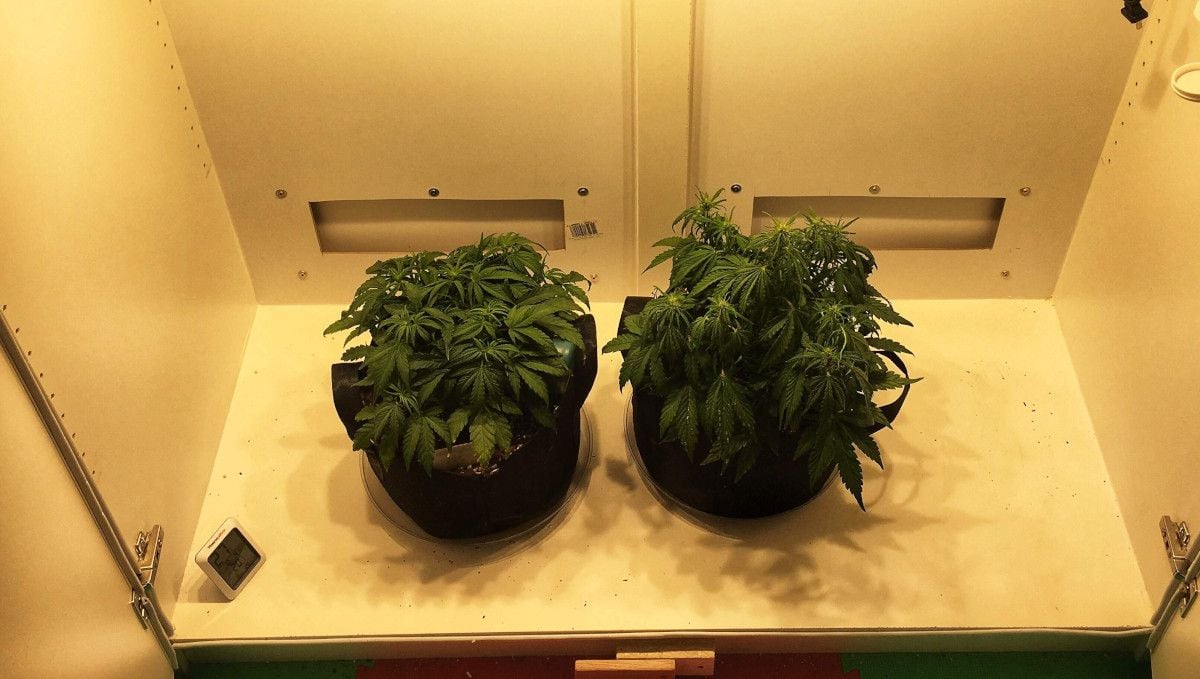
6. Transition (Pre-Flower) | Week 5
As your cannabis plant enters the pre-flowering stage, maintaining a consistent environment remains crucial. Aim for temperatures ranging between 73-77°F (23-25°C) during the day, slightly cooling off at night. We recommend maintaining a relative humidity level of around 40-50%. In terms of lighting, continue providing 18-24 hours of light per day, as autoflowers do not require a change in the light schedule to initiate the budding process.
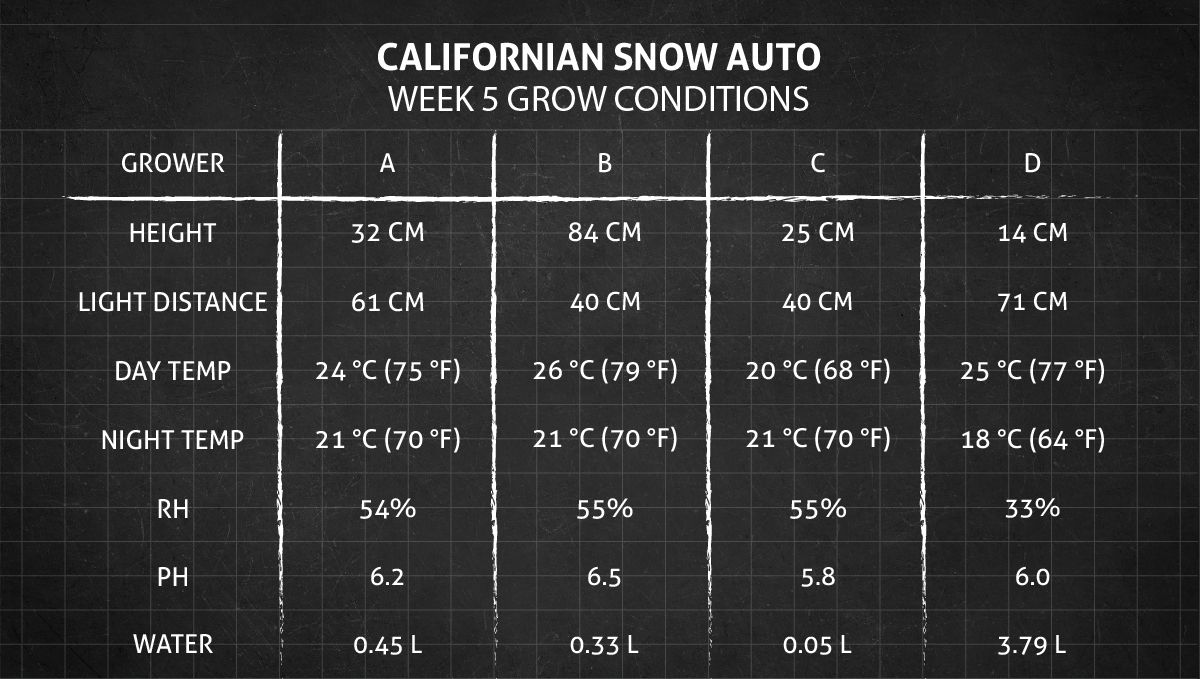
The pre-flowering stage is characterized by the emergence of pre-flowers, which appear as small white hairs primarily in the middle nodes and later at the tops of the plant. Unlike photoperiod strains, which can prolong this stage if you continue giving them more than 13-14 hours of light exposure, autoflowers will promptly transition into the flowering phase regardless of the light schedule.
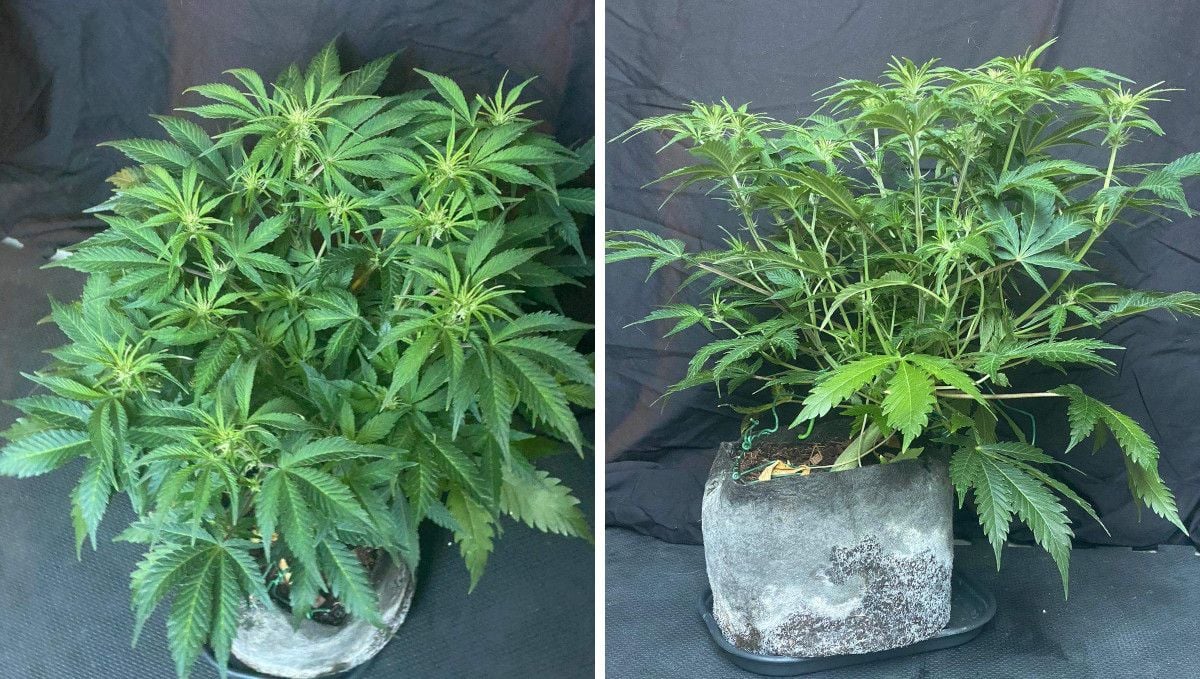
Within a matter of days, you will observe the tops of your autoflower exhibiting a yellowish hue, followed by the appearance of abundant white hairs and delicate, thread-like leaves. This transformation serves as a clear indication that your plant has embarked on the final leg of its journey towards harvest—the flowering stage.
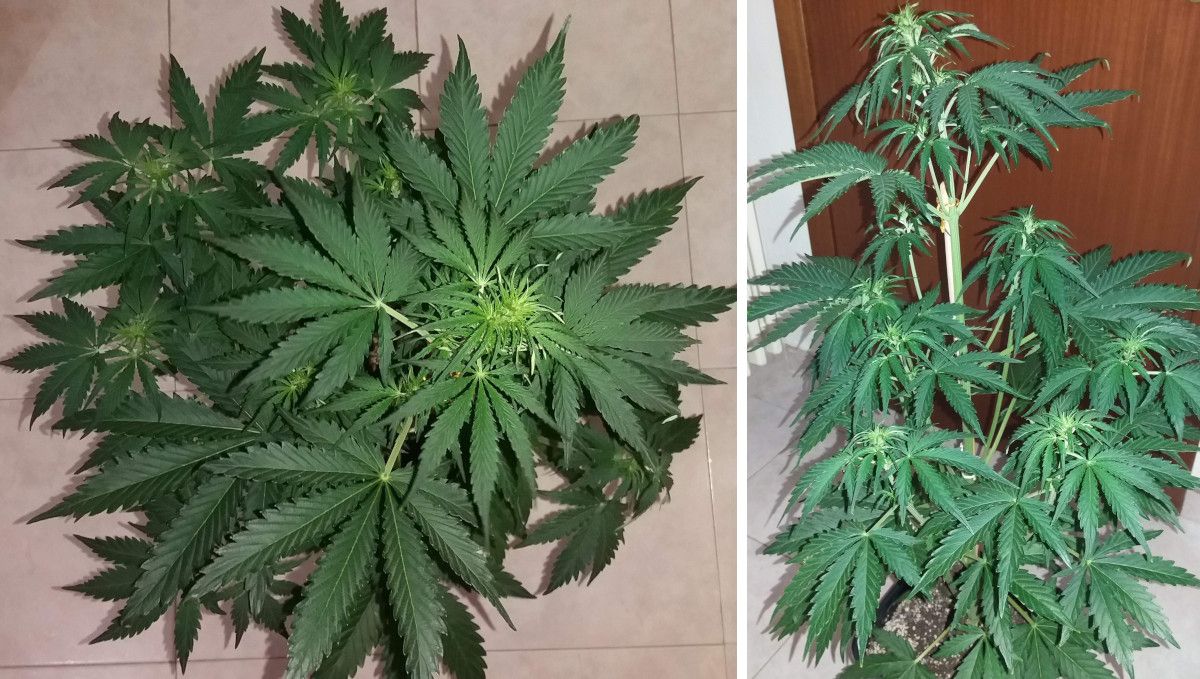
While there may be slight phenotypic variations among different autoflower strains, modern breeders strive to create faster varieties, resulting in Indicas, Sativas, and hybrids all initiating flowering early and around the same time.
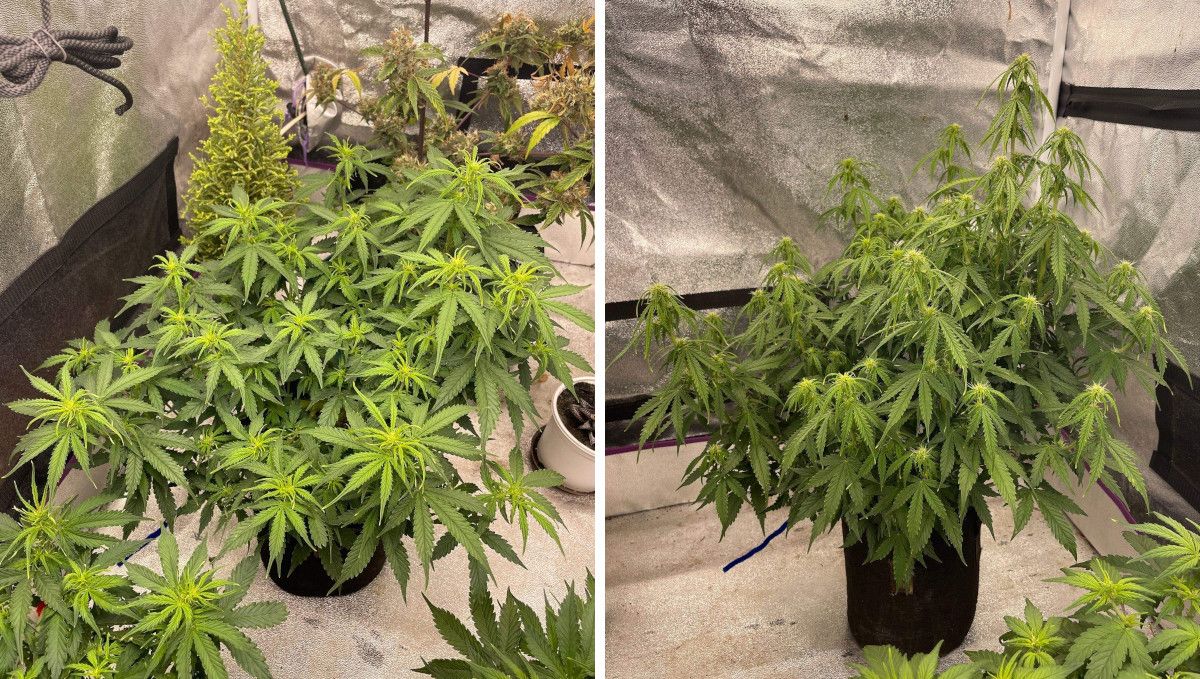
While it is not strictly necessary to adjust your nutrient regimen for flowering during this stage (though it will be essential in the weeks to come), many growers opt to make the transition. They replace the nitrogen-rich formula with a nutrient mix higher in phosphorus (P) and potassium (K), which are crucial for robust flower development.
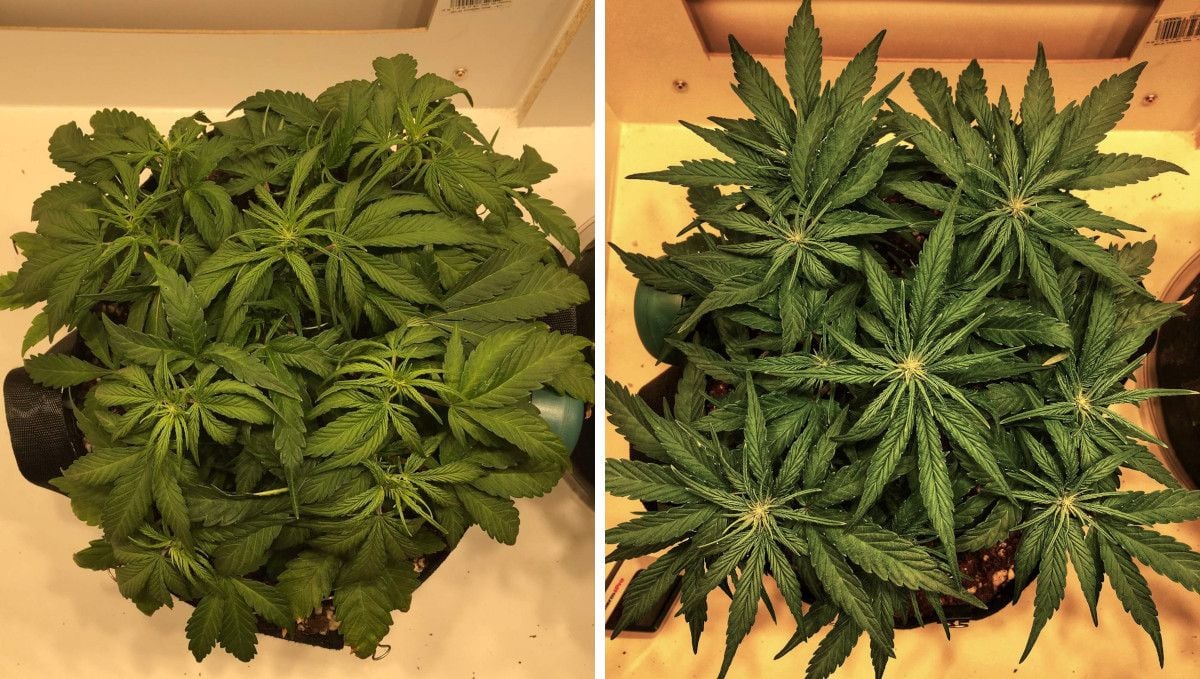
As the pre-flowering stage progresses, you may notice that the canopy of your autoflower becomes dense and potentially tangled. Taking proactive measures to manage the canopy is advisable, such as leaf tucking, selective defoliation, or pruning of lower and middle branches. By addressing these tasks early on, you alleviate potential stress on the plant during the later stages of flowering, allowing it to focus its energy on flower production.
7. Early Flower | Weeks 6-7
When it comes to growing cannabis, it's important to tweak the environmental conditions for each stage. As the flowering stretch begins in weeks 6 and 7, consider lowering the temperature just a tad. And remember, the humidity should be lower too, especially when those buds start filling out.
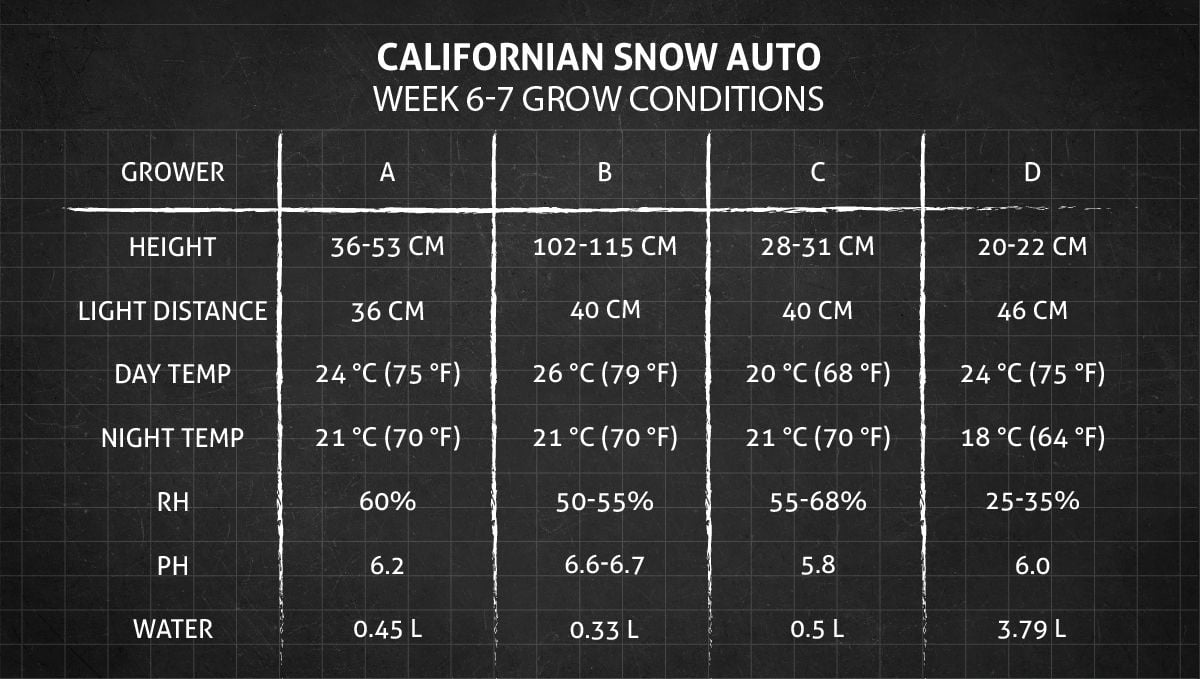
When your plant starts flowering, it goes all out and stretches its branches like crazy. They can double in size during the first couple of weeks. It's like they're reaching for the sky!
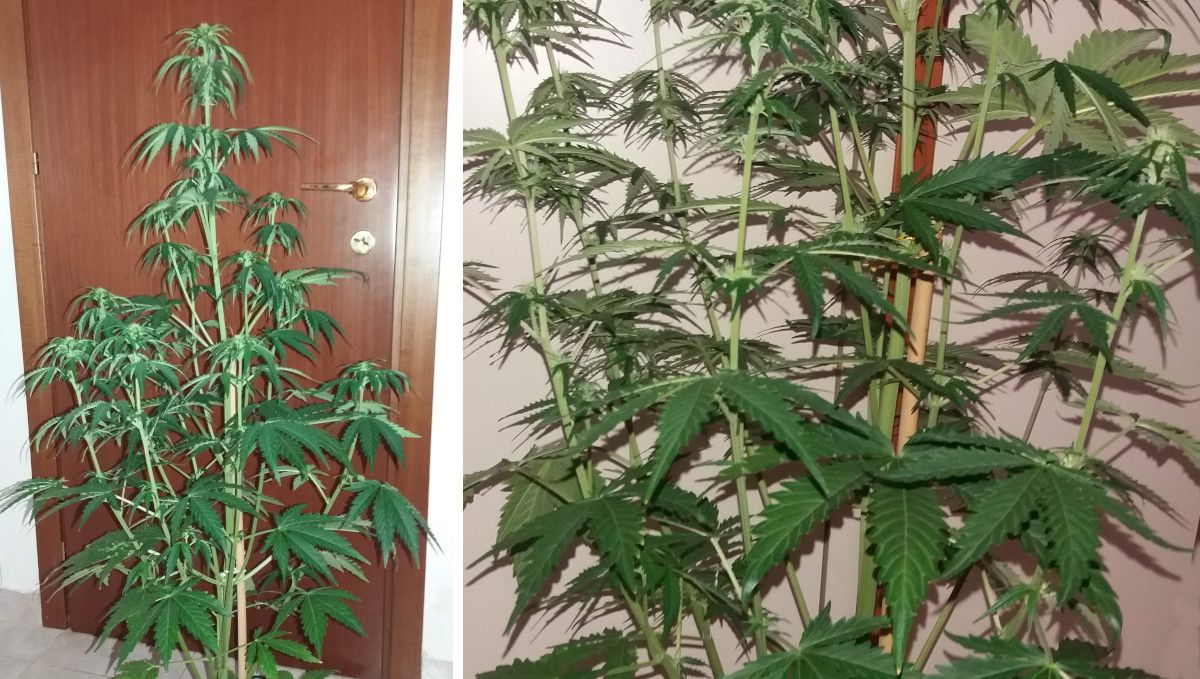
Now, if your plant looks like nothing you’ve expected, don't get discouraged. The flowers may seem small and lightweight at this stage, but trust us, they'll bulk up and become those big, dense colas you dream of. Just give your autoflower some time to work its magic.

As your plant grows bigger, it's gonna get thirstier. Young ones may need a drink every few days, while mature plants might want water every other day or even daily. Just check the weight of the container – if it feels light, it's time to hydrate.
Food is important too! Your plant's appetite will ramp up, so start increasing the nutrients you feed it. If you were giving it a quarter dose before, try moving up to full doses. Keep an eye on its health though, so you don't go overboard.
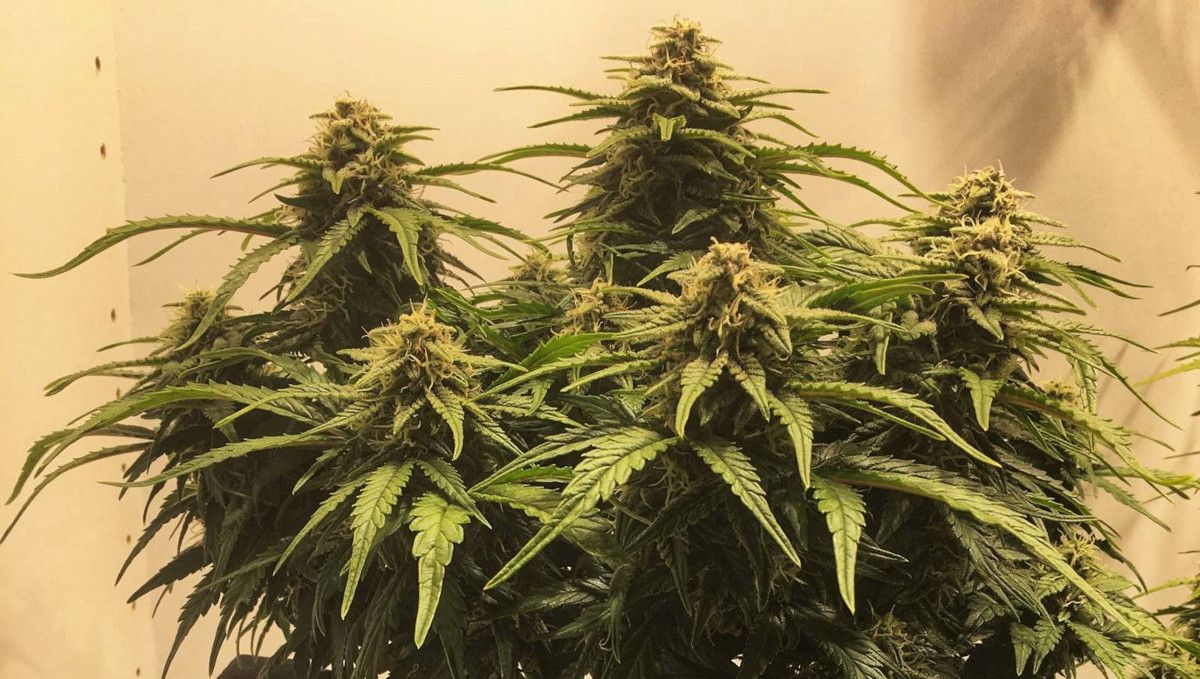
By now, your cannabis needs different nutrients for flowering. Phosphorus and potassium are the stars here, while nitrogen takes a back seat. Too much nitrogen now could mess things up, so be careful.
8. Mid Flower (Bulk Phase) | Weeks 8-9
As you enter the phase where cannabis flowers embark on their journey towards becoming big and firm, make it your priority to provide optimal airflow and maintain lower relative humidity levels. Stagnant air is your worst enemy as it leads to mold, bud rot, and other fungal infections. The dense and compact structure of burgeoning buds creates an ideal breeding ground for such issues to thrive.
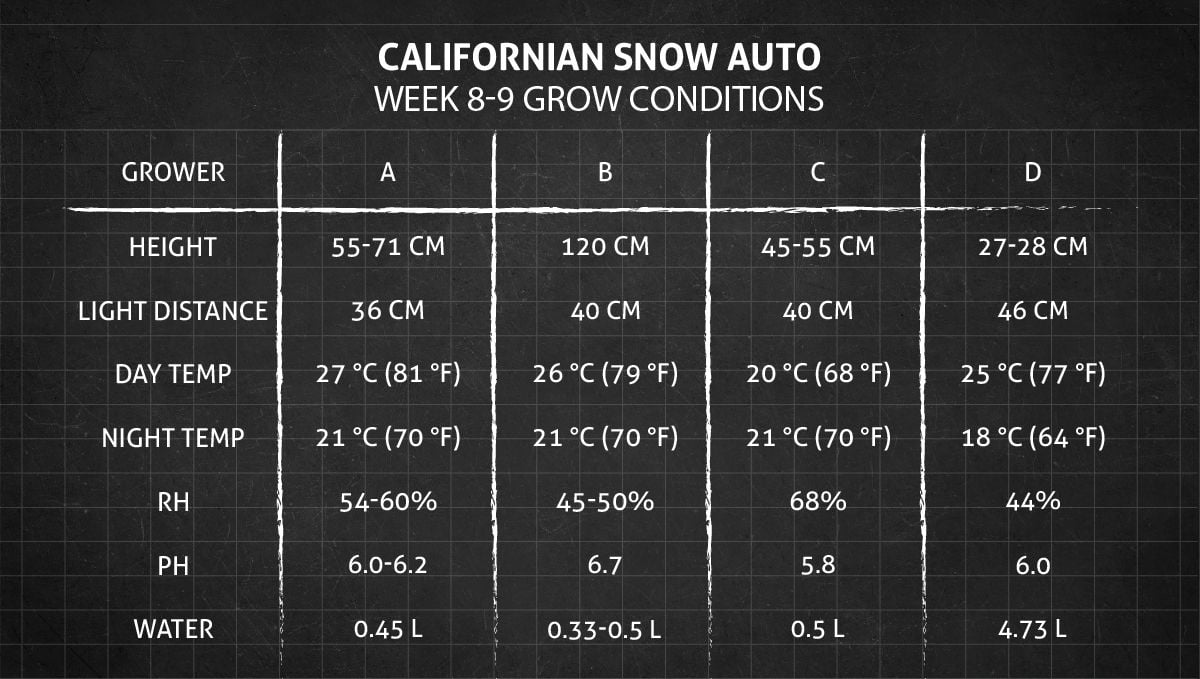
Throughout this phase, the flowers progressively extend along the branches, gradually turning into elongated and plump colas that captivate our senses. While their visible growth fills us with anticipation, their internal density also increases.
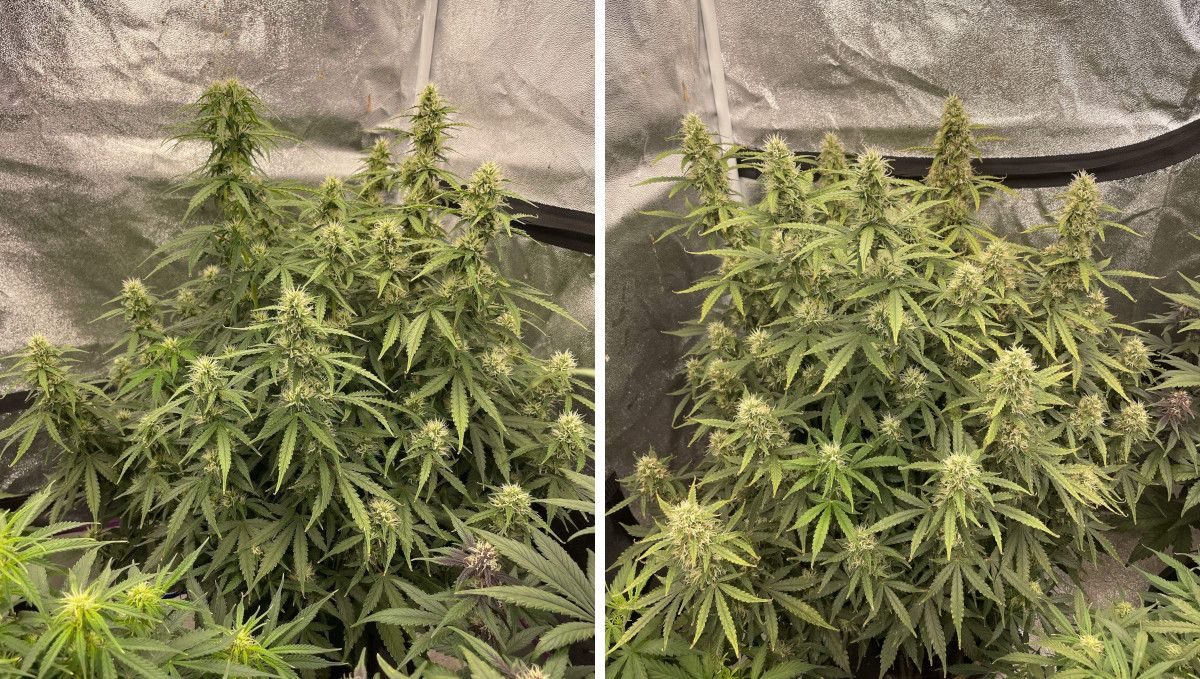
It is worth noting, however, that despite these promising developments, the pistils still retain their greenish-white hue which tells you that the maturation process will take some time yet.
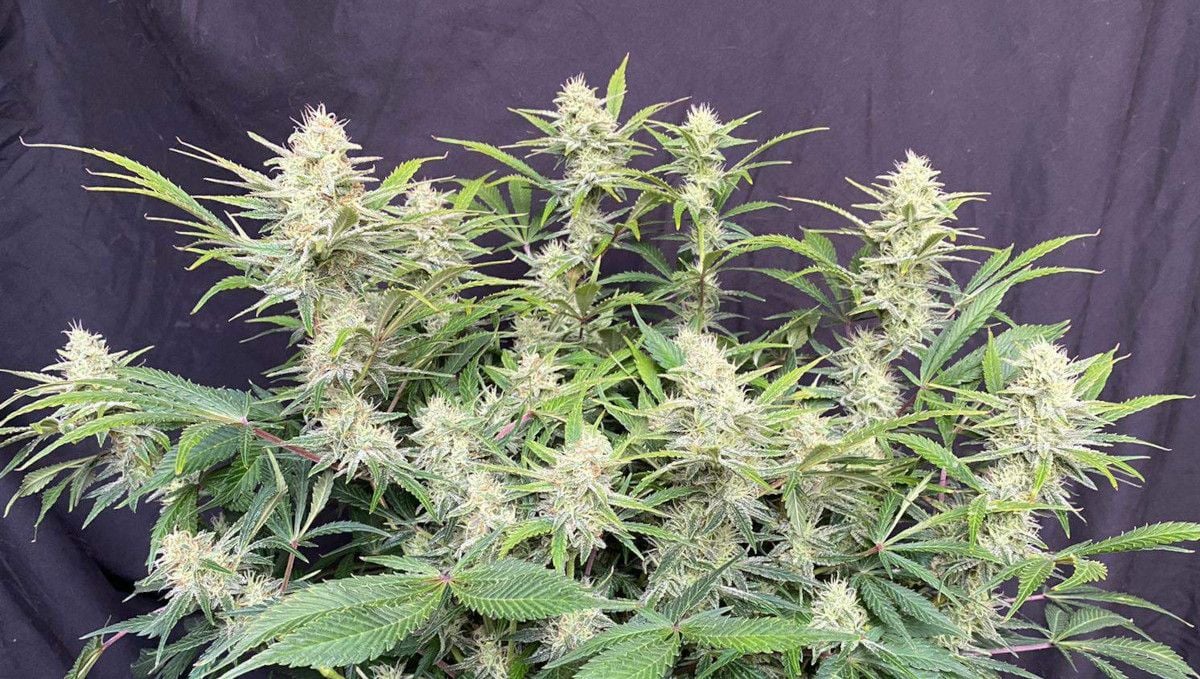
During this period, exceptional autoflowers like Californian Snow exhibit an enchanting display of frostiness as trichomes, resin glands abundant on the calyces and adjacent small leaves, come to the center stage now.
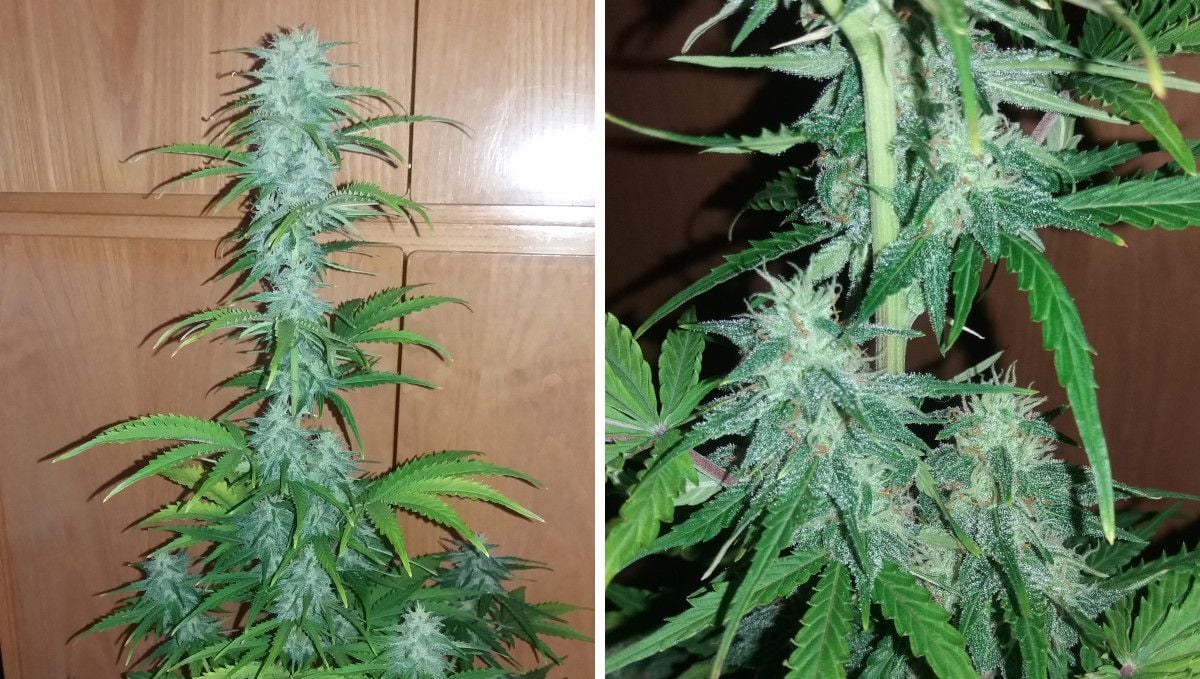
These trichomes serve as repositories for THC and other cannabinoids, hinting at the potential psychoactive power that will reach its zenith during the harvest. Moreover, these resin glands abound with terpenes, aromatic compounds that will later impart distinctive scents to your smoke but now fill your grow room with a potent and alluring fragrance.
As the flowering stage progresses, cannabis plants typically cease their upward growth, maintaining a steady size until the moment of harvest. Consult the table below for insights into the week-by-week height gains of Californian Snow Auto.
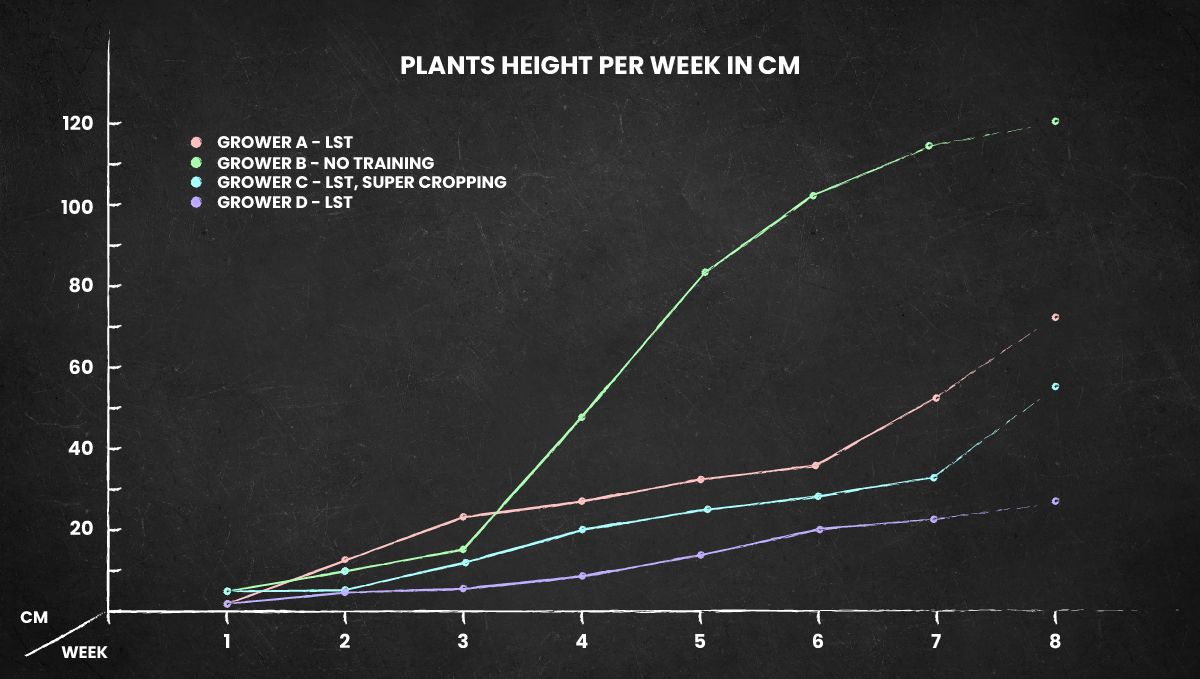
With concerns of excessive stretching now behind you, your whole attention can turn to the fundamental aspects of proper watering and a nutrient regimen tailored to this stage. It is crucial to make the most of this final phase of feeding your autoflower.
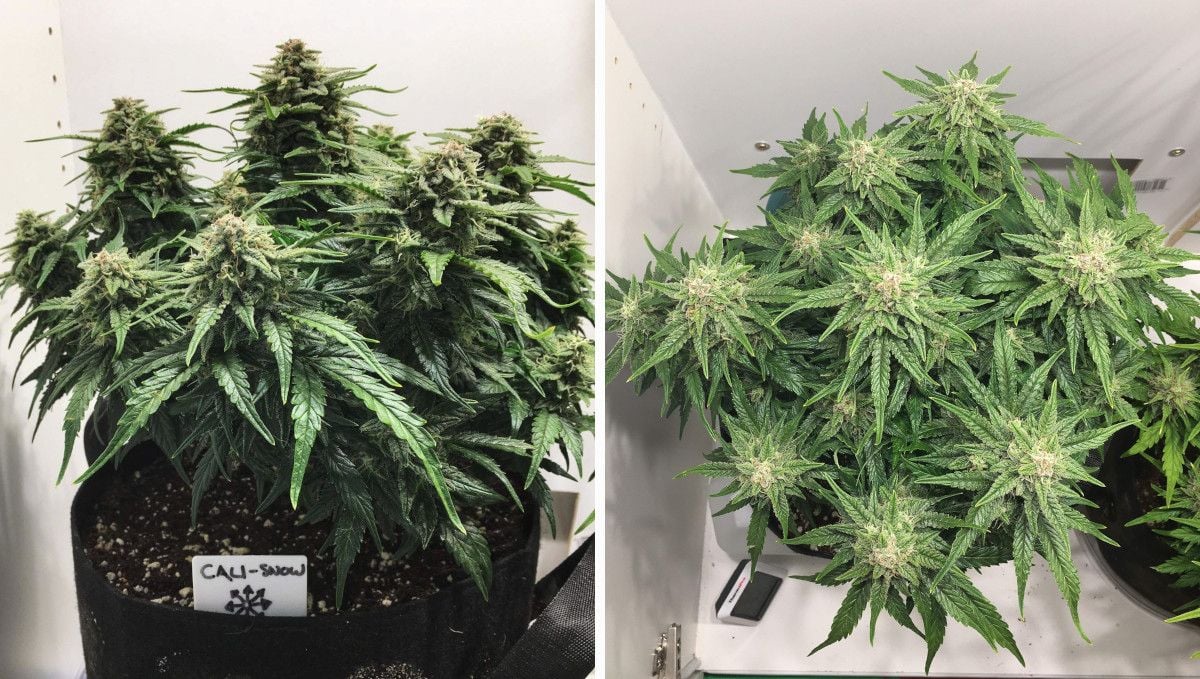
We suggest that you should focus on phosphorus and potassium now -- whether through an integrated base formula or a dedicated PK-booster. As you advance to the next stage, you'll gradually taper off feeding, ultimately transitioning to just plain water.
9. Ripening And Harvest | Week 10 (And Beyond)
In the weeks leading up to harvest, it's important to control the humidity and keep things cool. Hot temperatures may speed up THC degradation, while terpenes evaporate faster when it's too hot. Be cautious of high humidity too, as the risk of fungal infections is as high as ever.
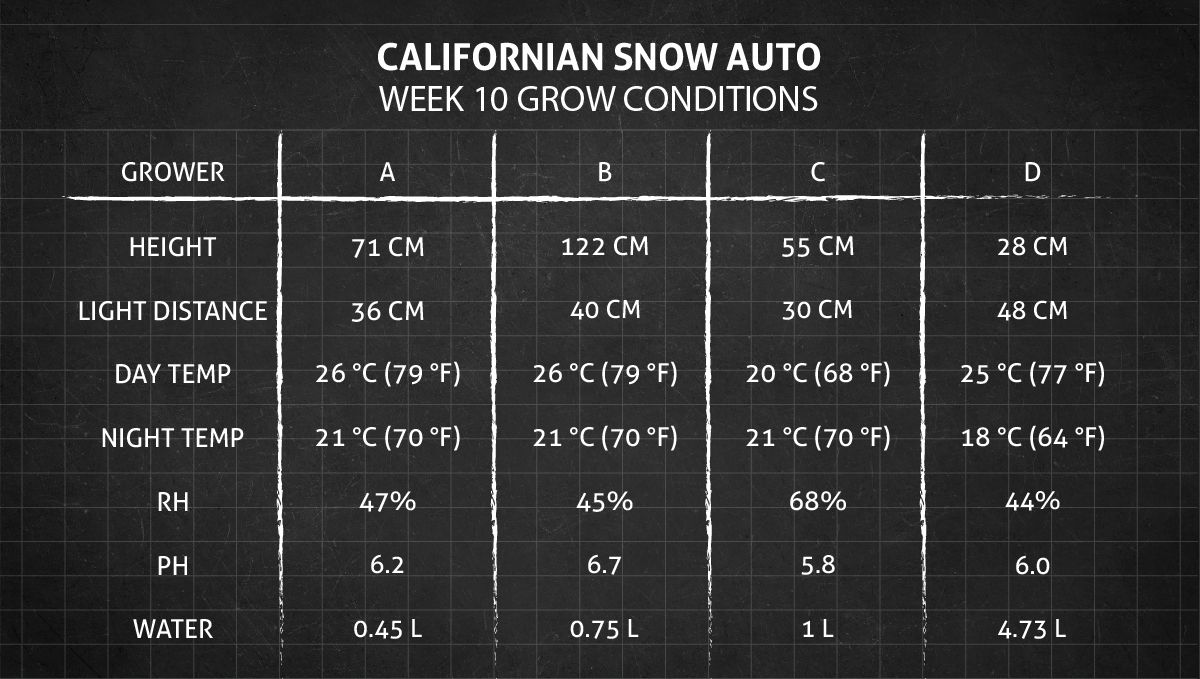
As the maximum duration of your autoflower's life cycle approaches, your buds will look more mature each day.
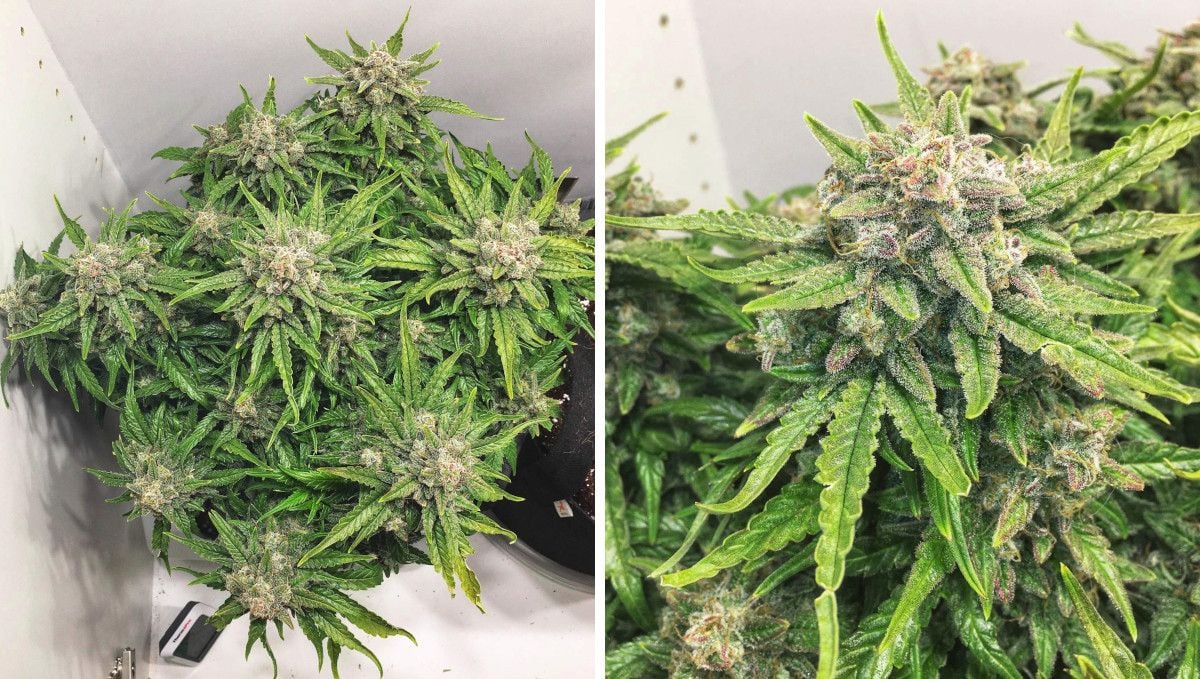
You can't rely solely on the breeder's guidelines for when to harvest, as plants of the same strain may grow differently. A more accurate method is to observe the pistils. If they're still white, the buds aren't fully mature. But if they turn brown or orange, harvest time is likely approaching. The leaves may also fade, giving an autumnal appearance as the plant nears the end of its life cycle.
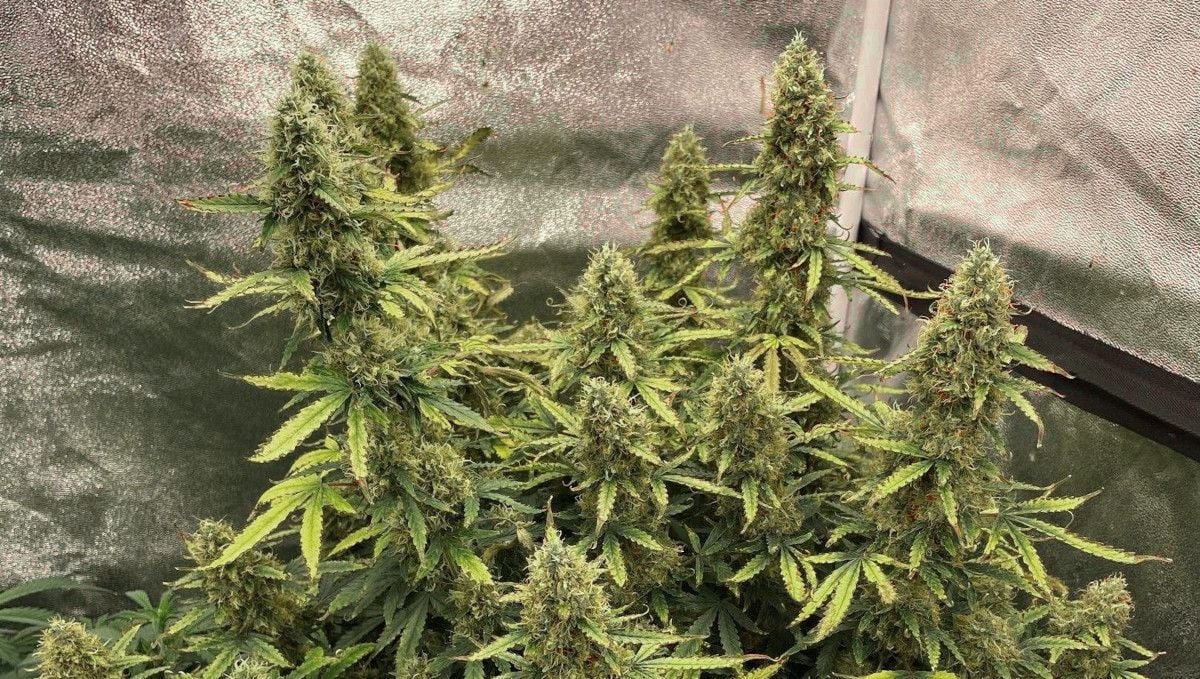
To harvest at the peak of potency and flavor, examine the trichomes with a microscope. Look at the milky trichomes covering the calyces, not the trim leaves. When most trichomes have turned milky and some are amber, it's the optimal time to harvest.
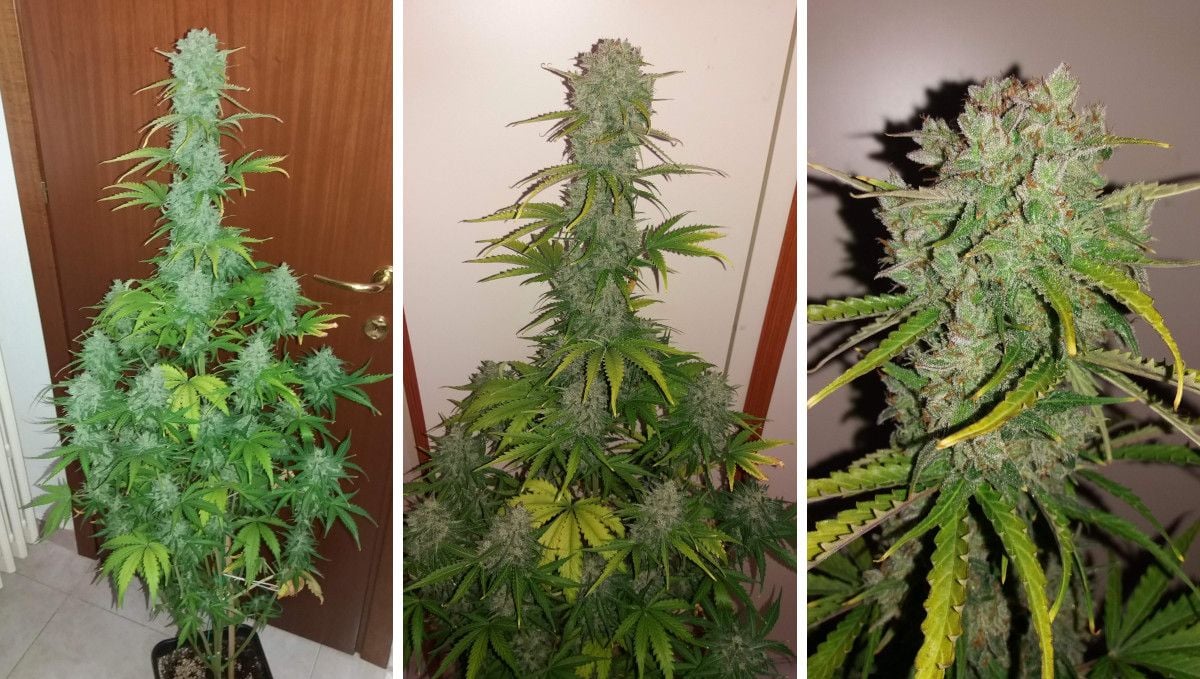
Before reaching this peak maturity, stop giving your autoflower any plant food and flush the growing medium with water. This process removes accumulated salts and unwanted chemicals that could affect taste and safety.
This flushing step, called the final flush, takes around 2 weeks in soil grows and about a week in hydroponic setups. Aim for proper timing to ensure your buds are fully cleansed before harvest.
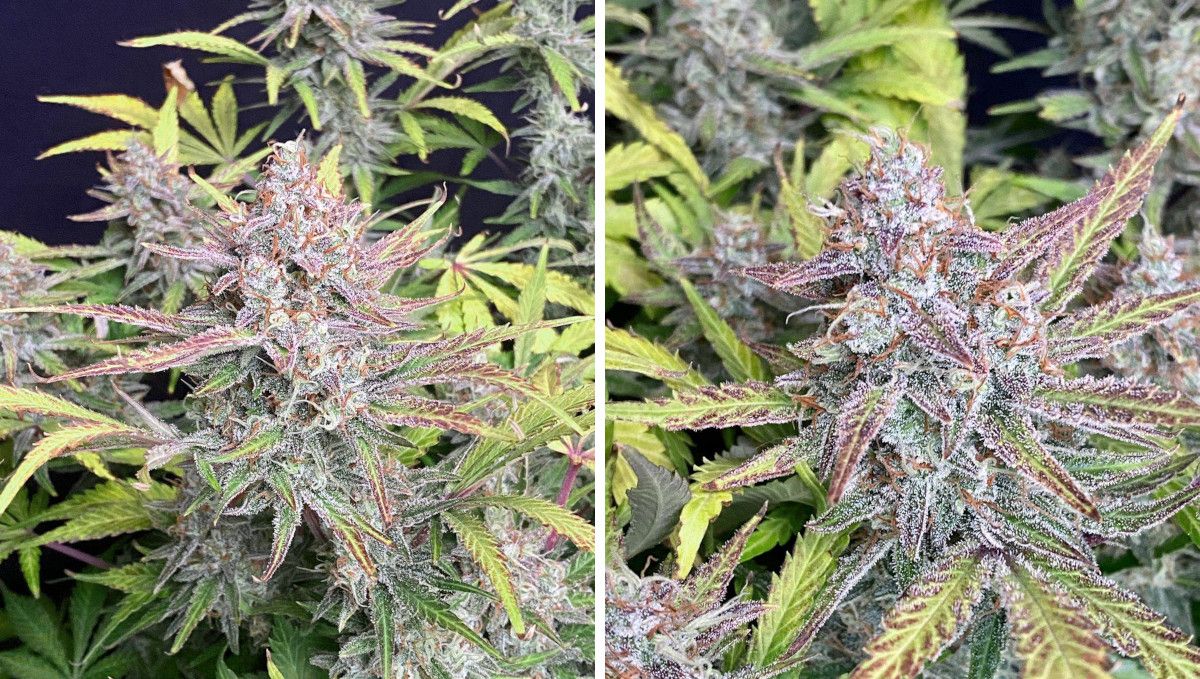
The quality of your smoke also depends on drying and curing. Allow your cut branches to slow-dry for 5-7 days, then snip off the buds and cure them in glass jars for another 2-3 weeks. Remember to open the jars regularly to release excess moisture.
10. The Outcome
Though the grow diaries we picked weren’t the most high-yielding out there (we preferred to choose the ones with better-quality photos instead), Californian Snow came out as a top producer in all 4 of them. Whatever the particular circumstances, conditions, and cultivation methods were, this autoflower delivered big time.
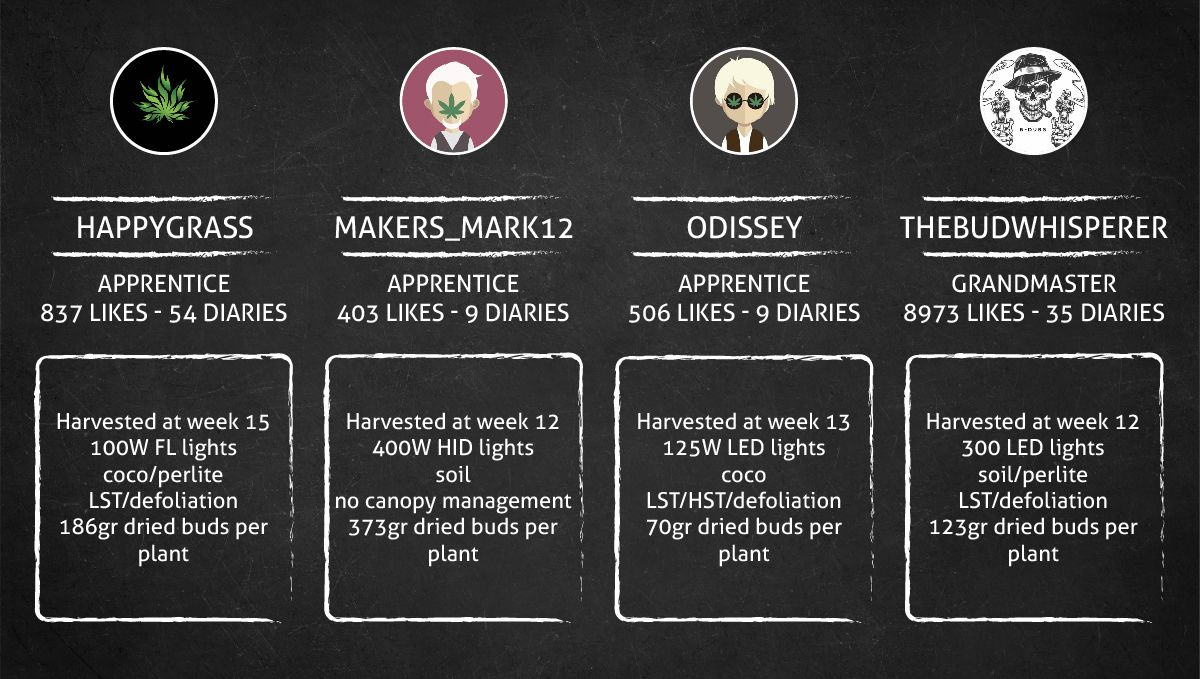
Californian Snow Auto Yield
The record-setter in our week-by-week guide, Grower A made full use of his autoflower's long veg and unhurried flowering and harvested 186 g (6.56 oz) from it after 15 weeks from sprouts.
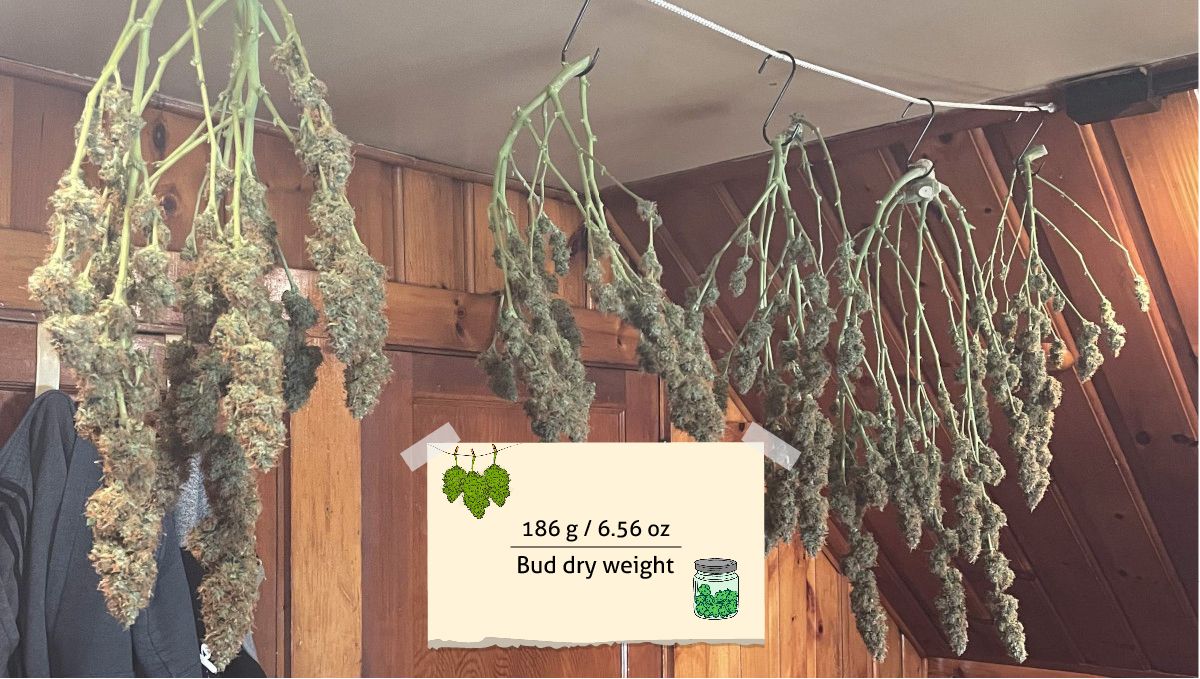
Grower B can be proud with the oversized central cola on his tall, untrained plant, but other buds were impressive too. The whole yield was 84 g (2.96 oz).
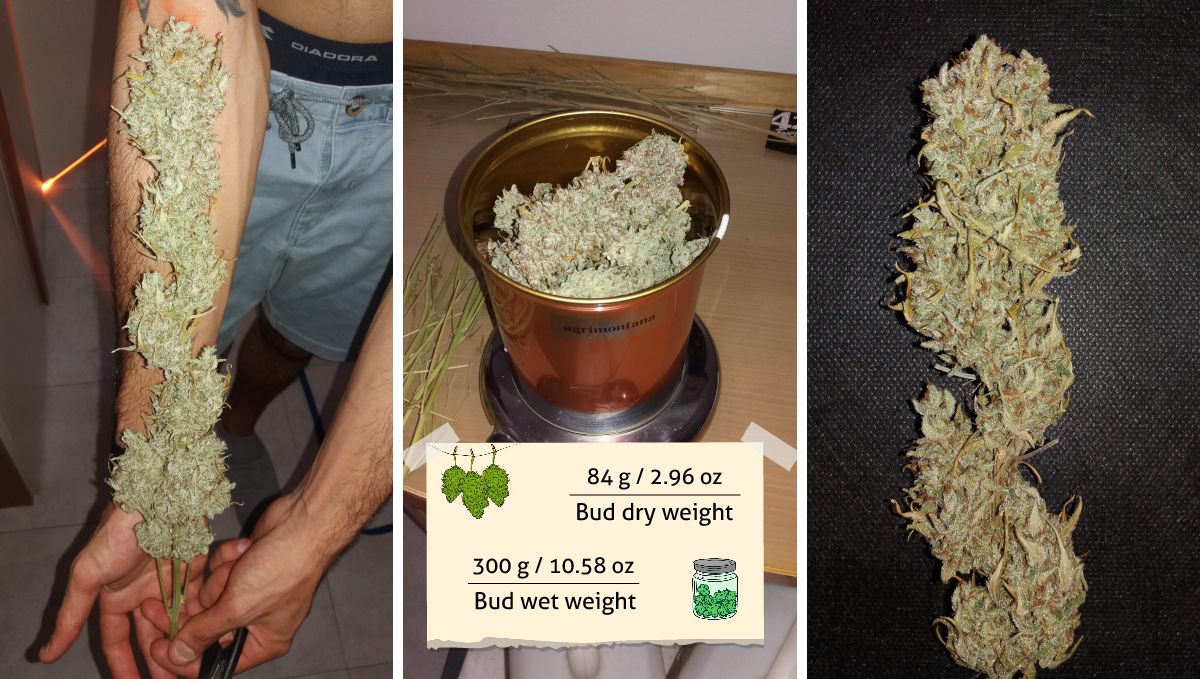
Grower C's plant, though medium-sized, had a lot of branches covered with dense flowers and brought an impressive yield of 70 g (2.47 oz).
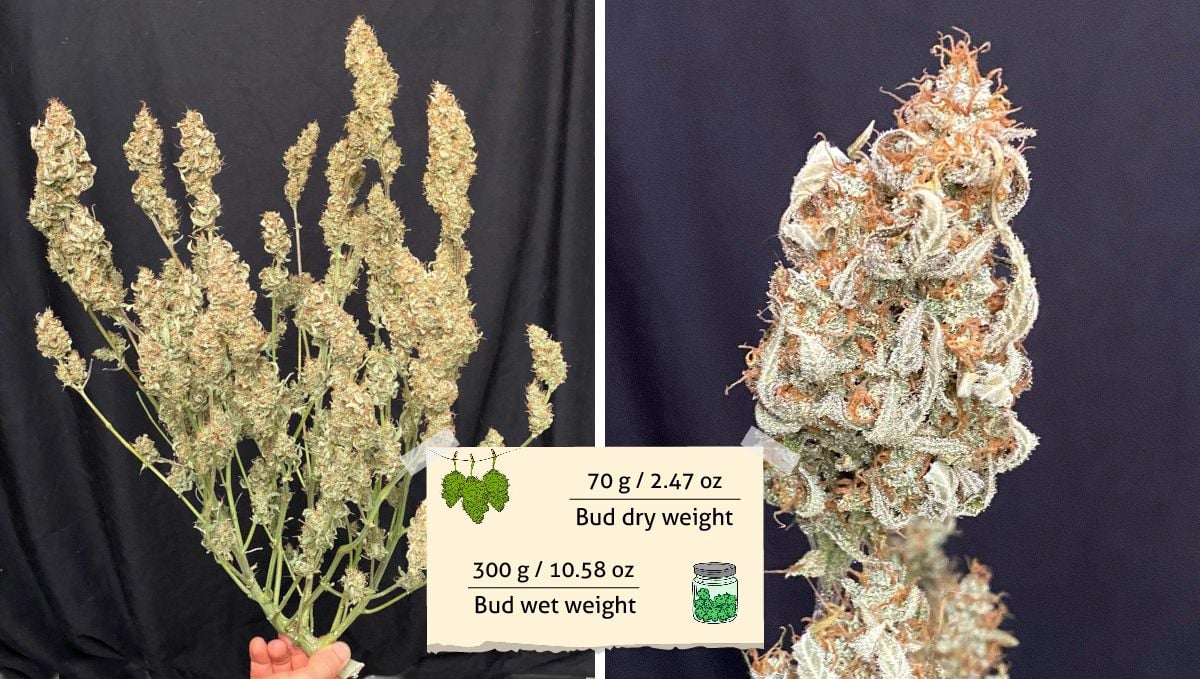
Finally, Grower D's Californian Snow was an outlier. Though it kept close to the ground till harvest and stayed shorter than most Indicas, the texture of its colas was so dense that the yield was second-largest at 123 g (4.33 oz).
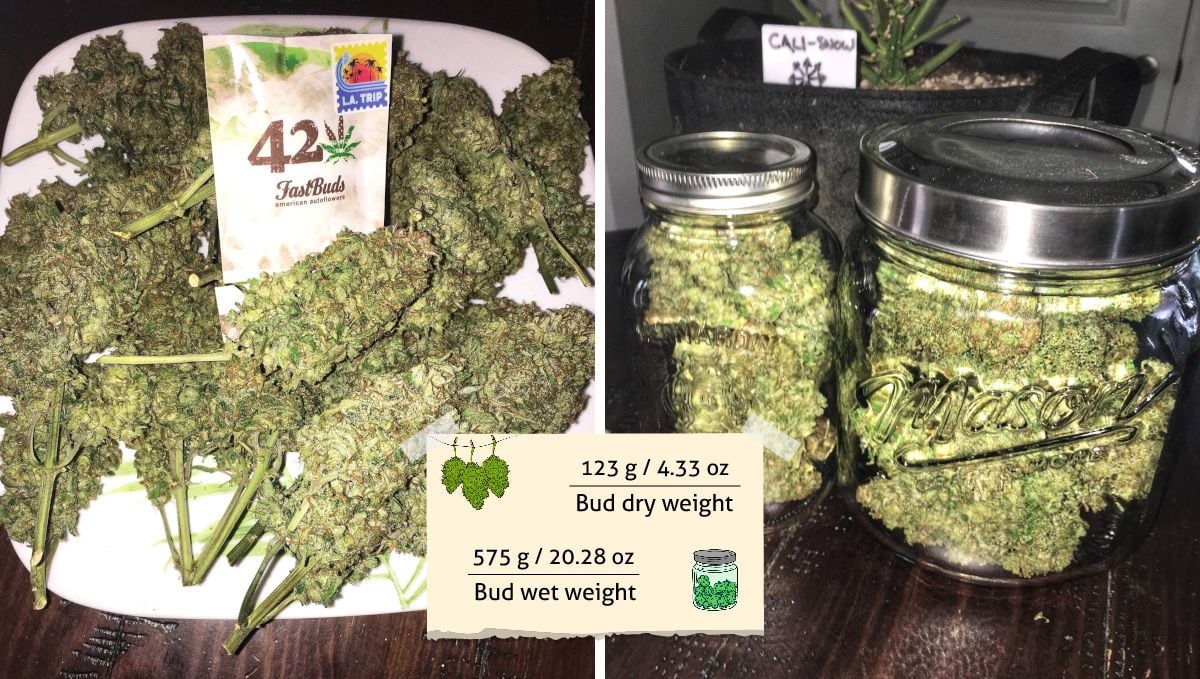
Californian Snow Auto Smoke Report
The smokers that have reviewed Californian Snow Auto highlight its pleasant aroma, sweet and fruity flavors, and uplifting effects. They describe the scent resembling apple pie, vanilla, and crisp green apple. The high is predominantly Sativa, providing an invigorating and energetic feeling, perfect for daytime use and social gatherings. Users appreciate its ability to alleviate anxiety and provide motivation. To some users though, it offers a stony and intense high with a confusion of thoughts, and couch lock may be a possibility, so moderation is advised.

10. In Conclusion
Based on the grow diaries available online, we can assure those Sativa lovers who are reluctant to grow a potentially tall Sativa autoflower indoors: don't be afraid to try Californian Snow Auto, as this conveniently accomodating cultivar can be trained into any shape you want.
Grower B, for example, refrained from training it altogether and got a tall plant with a dominating central cola. Maybe he got a less impressive gram-per-plant yield than others, but on the other hand, his Californian Snow Auto occupied only a small surface area and he had enough room for more plants.
Grower A took training more seriously. Luckily, the veg was long in his case and allowed him to get a big and tremendously bushy plant which was also the most productive. Grower C trained his Cali Snow as well and managed to turn it into a multi-branch plant with a generous yield of many colas with the same size and texture.
Grower D's auto remained low-profile even without training and compensated its modest size with the density of buds seldom seen in a Sativa-dominant variety. The other three plants in our guide had quite dense and solid buds as well.
Between 12 and 15 weeks from seeds, Californian Snow wasn't the fastest of autos, but a few extra weeks are worth waiting considering a record-breaking productivity. None of the growers faced any issues either, providing proof that this is a strong and resilient genetics.
In short, Californian Snow Auto is an indoor grower's dream and will be a pleasure to grow for a gardener with any level of expertise or none at all. Happy growing!









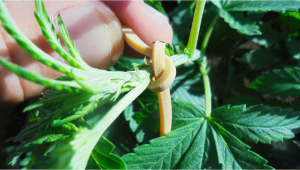



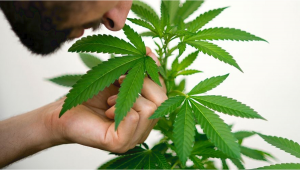



Comments